Since June 6th, the day the Kakhovka Dam breached and inundated a large part of the downriver areas, a lot of new information has come to light, and I found a study by an engineer with 15 years of experience in hydraulic infrastructure, who looked at this collapse. The timeline and different causes of the various phases I will present, now paint a picture that I am 100% confident portrays what actually happened. It explains ALL the details that are visible in the pictures and videos of the dam before and after the collapse. I will repeat part of my previous article, in order to present the full story here, so this article can stand on its own. If you like this analysis, and think it true, share this article!
Why is this important to revisit?
Because the narrative is still that Russia did it, and this is used and abused in the current information war. Andrew Zuo wrote an article “NATO Is Going To Regret Not Responding To The Kakhovka Dam”, where he sternly warns that NATO should have done something. He quotes Zelenski: “Unfortunately, there was no timely and large-scale response to the terrorist attack on the Kakhovka hydroelectric power plant. And this may incite the Kremlin to commit new evil.” Lesson: NATO needs to be more aggressive.
It is used to push the idea of ‘ecocide’ by Russia, a war crime as established by the United Nations International Law Commission in 2022. A July 19 article by Eugene Stakhiv, Andriy Demydenko and Analytics Society in Vox Ukraine, titled “Ecocide: The Catastrophic Consequences of Kakhovka Dam Demolition”, wrote in their summary “What consequences does the destruction of Kakhovka dam by Russians has for people, nature and economy? How to quantify these consequences? How to bring Russia to responsibility for the ecocide? This article provides some ideas.”
More careful stories and reports talk about ‘suspected Russian sabotage’, such as the July 31st article by Jędrzej Nowicki in The Atlantic, titled ‘After the Deluge’.
Still, articles like this one by The Interpreter, titled ‘Unleashing chaos: Nova Kakhovka Dam destruction threatens global food security’ only softly imply a Russian hand in the collapse. “While Ukraine currently controls five of the six dams along the Dnieper River, the Kakhovka dam – the furthest downstream in the Kherson region – has been under Russian control since President Vladimir Putin launched his invasion of Ukraine in February 2022.” This was the closest the article got to discussing who was responsible. But the article makes clear how the collapse endangers the global food security. Within the overall consensus in the West: Russia’s fault.
The New York Times wants us to know there is little doubt, in an article titled ‘Why the Evidence Suggests Russia Blew Up the Kakhovka Dam’. The authors write, in an otherwise beautifully interactive online article: “The evidence suggests Russia blew it up from within.” A little further in the article, Ihor Strelets, an engineer who served as the deputy head of water resources for the Dnipro River from 2005 until 2018, was quoted. He said that “as a Cold War construction project, the dam’s foundation was designed to withstand almost any kind of external attack.”, and that “he, too, had concluded that an explosion within the gallery destroyed part of the concrete structure, and that other sections then were torn away by the force of the water.”
With a little flair for drama, the articles continues: “I do not want my theory to be correct,” Mr. Strelets said. A large explosion in the gallery might mean the total loss of the dam. “But that is the only explanation,” he said.”
One of the key images in the article found its way to the Wikipedia on the Kakhovka Dam, which illustrates the core theory:
Wiki states as fact that “On 6 June 2023, an explosion caused significant damage to the central section of the 3.2 kilometres (2.0 mi) wide dam, resulting in uncontrolled water flow downstream”. Interestingly, with enough awareness to add [Citation needed]. Still, Wiki quotes the New York Times to indicate the cause: "the most likely cause of the collapse was an explosive charge placed in the maintenance passageway, or gallery, that runs through the concrete heart of the structure" and that "the evidence clearly suggests the dam was crippled by an explosion set off by the side that controls it: Russia."
A look at the schematics from the Soviets who built the dam, however, shows a slightly different situation. Why that is important, apart from a documented case of careless (?) reporting, will become apparent later in this article. I published this in my first article:
For completeness and fairness, I also found this schematic:
This was more to depict the full design of the anchoring and sealing slab in front, and the dissipation zones behind the spillover part, and as such was not intended as an accurate schematic of the actual spillover. There are some important differences between this second schematic and the actual dam, which shows that the one I had published earlier is the correct schematic.
So, what happened?
Allow me to recap, and add the new elements.
On November 12, 2022, the retreating Russian Army, coming in from Kherson, detonated the last 3 road and railroad slabs, to prevent Ukrainian access from their side of the dam.
Notice also the trench lines and shell holes on the earthen dam, on the right side:
There was also damage from Ukrainian shelling:
The next one is important. Notice the pillar upon which the road deck rests, and the wall connecting it to the main spillover dam section, right under the words ‘supernova plus):
One more, that matches the tweet by Timothy Hurley just a bit below, showing the view from the road surface.
That those attacks were made by the Ukrainian army is beyond any doubt, as the source for those pictures is the Odessa Journal, in an article from August 13, 2022.
A engineer minder user on Twitter made the following observation. Notice his remark on eroded concrete: with a Soviet structure from the 50s, to be expected. This says something about the state of the dam itself, prior to the hostilities.
A pro-Ukrainian source posted a video, from which I took the following still, showing the damage in the road surface of the S turn, attempts to repair temporarily with metal plates, and in the front damage to the railroad. The green numbers correspond to the sluice gates, the 4th being of particular note, see below.
A tweet reported this:
This matches the description given by Maj. Gen. Andriy Kovalchuk, the initial commander of the Ukrainian counteroffensive in the Kherson region. (Ukrainian Operative Commandment South), as reported in a long article by the WaPo that has been cited often these last few days.
Attacks were made, most aimed at the bridge parts, sparing the dam, but at least one deliberate attack on the floodgates themselves was made, as well. There is photographic evidence of the result of that single sluice gate that got damaged, as reported on Twitter by Brumfiel:
Of note is that this is gate 4, very close to the S turn. The importance of that will become clear further in my analysis.
As a later addendum, based on an article that reader Starmax777 shared in the comments of my first article on the Kakhovka Dam, a list was published that seems to give a rather exhaustive and complete chronicle of all the strikes at the Kakhovka dam and power plant, with dates and type of munition used.
Among a much larger list of accounts of at times ‘massive’ shelling, from artillery as well as rocket fire, aimed at the Power Plant building itself, the following are of note:
On July 18, 2022, the control room of the shipping floodgate was damaged during an attack on the HPP.
On August 5, 2022, the hydroelectric power plant came under a massive shelling attack. It was hit by HIMARS, Olkha MLRS, and Tochka-U.
On August 12, 2022, three of the six turbines of the power plant were damaged as a result of shelling. The HPP was switched to emergency mode (half of the design capacity).
On November 6, 2022, the HPP was hit by six HIMARS missiles. One of them hit a floodgate, which was damaged.
The article also provided the the following statement by Vladimir Leontyev, Head of the Novokakhovsky District from March 14, 2023, “that the HPP is hit regularly; in addition, sabotage and reconnaissance units of the Armed Forces of Ukraine are regularly attempting to penetrate the territory and the dam. He said that snipers are also working actively, preventing repair and maintenance work on hydraulic structures.” I had earlier read an allusion to that, but without any further information to check it, even though a first attempt to find confirmation of his words failed to turn anything up. This confirms the statements about the Russians having trouble operating the flood gates.
Were such attacks justified? Russians had military positions on the dam and the power plant buildings, but those were by nature static and defensive, on a position that did not really allow an attack. What was the urgent military need to attack this sensitive structure like that?
An even-keeled article by the West Point Lieber Institute, titled ‘International Law and Accountability for the Nova Kakhovka Dam Disaster’ from their series Articles of War, this one dated July 13, 2023, pointed out that “The other important prohibition under international humanitarian law relevant to the Nova Kakhovka dam incident concerns the protection of objects indispensable to the survival of the civilian population. The prohibition relating to such objects is not confined to “attacks” but also proscribes destroying, removing or rendering useless such objects (Article 54, AP I).”
Is shelling of an object that is not really part of a military action, not the object of an offensive, and is of vital importance to the local civilian population, a violation of that Article? It would certainly seem so, as are the actions to prevent Russians from operating the Dam and its infrastructure by such constant shelling and sniping.
This is how it started, and the whole story of Kakhovka Dam in a nutshell:
The actual beginning is late 2022, when the Russians start to slowly drain the Kakhovka Reservoir. Slowly, as damage to the installation made that work very difficult.
This can be seen on water level charts from a variety of imputable sources. The following chart comes from an international group, Theia, that tracks water levels all over the world (as seen on the blog from Simplicius):
First, the water level decreases to well below the average. This caused a lot of concern on the Ukrainian side, as this clearly was because of deliberate action by the Russians.
This can be seen from several articles from November 2022, such as this one from Censor.Net, with a decidedly anti-Russian tone, titled "Occupiers are dumping water from Kakhovka Reservoir, bringing disaster at ZNPP closer.”
The article states: “As NPR writes, since the beginning of November 2022, water has been gushing from the Kakhovka reservoir in southern Ukraine through the sluice gates of a hydroelectric plant controlled by the Russian occupiers. Satellite images show that the water level in the reservoir has fallen to its lowest level in three decades.”
The American based international organization Hydro Review confirmed that, in an article from February 2023, titled “Russia needs to restore function of Kakhovka hydroelectric plant, Ukraine PM asserts”. They wrote “Ukraine said it “calls on all available means to put pressure on Russia to close the gates and restore the hydraulic structures” at the Kakhovka plant, or to allow Ukrainian specialists to do so”, signaling that Ukraine was very well aware of what was going on, and demanded the Russians altered course (which would benefit Ukraine, and not Russia). They also reported that “the UK government’s Ministry of Defence issued an intelligence update on the situation in Ukraine on Nov. 16, specifically related to Kahkovka Dam”, signaling that Western governments and intelligence agencies had this dam on their radar, too, early on.
This next chart zooms in on the next phase, a sudden increase, starting in mid February, a rise in water level due to actions undertaken by the Ukrainian agency for hydroelectric power plants, Ukrhydroenergy, channeling water from upstream reservoirs into the Kakhovka Reservoir (source: twitter)
A pro-Russian account on Twitter noted the following, confirming what the pro-Ukrainian Intermarium 24, quoted earlier, had suggested:
She sounds the alarm over the sudden increase and points out that it was about to reach critical level, endangering the integrity of the dam, as well as that this was because Ukraine (Kiev) had opened the floodgates from the higher placed dams and reservoirs on the Dnieper. But she added a new element: that the Kakhovka dam had been damaged, and that this made operating the water level controls very difficult.
Russian Security Council secretary Nikolai Patrushev stated the following:
"Blowing up Kakhovskaya dam is another planned terrorist attack by Kiev regime.
Kiev first made a large-scale water discharge at the Dnieper hydroelectric power plant and then struck the Kakhovka hydroelectric power plant." He was aware of the actions of Kiev regarding the water level, but he was wrong about them ‘striking’ the power plant, as we will see. (Ah, I spilled the beans, it seems! Only partially, you will still be surprised at how mundane the real story is.)
It can be seen that at least 3 of the sluice gates, numbers 5-7 were open:
This is also reflected in this very nice chart from David Helms:
Notice how the blue squares show the position of the gantry cranes, used to lift or lower the sluice doors, the red shows the 3 damaged sluices where the Russians had blown up the road deck, slightly damaging the sluices, and green sluices with evidence of water discharge. Notice that from November 12 on, the retreat of the Russians, there was very little to no movement of the gantry cranes (they tried, but then stopped), and as a result no other sluices were opened. The 2, later 3 sluices with evident water discharge, were the sluices which were damaged by the Ukrainian barrages.
Slavyangrad posted on Telegram the following:
“Here are two reports. The first is the Ukrainian TG channel Resident, which reported that as late as last night, on Kiev's orders, a large release of water started at the Dnieper hydroelectric dam (the previous one before Kakhovskaya).
And that this is the case is indicated by a report from the guys at the dam breach site. It turns out that after 10 hours, the water level in the reservoir is not falling (as was supposed to be), but ... on the contrary is growing (see video).
This means that Kiev, even if originally it was not intended to destroy the dam, is now doing EVERYTHING to make sure the flow of water takes it down to the very end!!!”
On the accompanying video, it can be clearly seen that the dam has completely collapsed, it is midday, and the water level is still very high, much higher, indeed, as expected (even though hard to gauge with the structure as demolished and sunken lower than normal).
This completes that story: Ukraine was very upset about the low water levels, and demanded Russia fill the Kakhovka Reservoir again. When the Russians were understandably less than forthcoming, Ukrainians took matters in their own hands, and started to release massive amounts of water from the higher lying reservoirs, in order to force a leak, and pin that on Russia.
How could they know something bad would happen? Because even pro-Ukrainian Western source/expert David Helms reported already in early May, when the rising water had become apparent, that ‘over-topping’ a dam is very risky (remember the Oroville Dam?).
Pictures show clearly that this was happening:
Notice from this earlier picture how there was NO water flow over the spillway, except where the Russians had opened the sluice gates:
So, what happened?
Now we laid out the preconditions and early events, the cascade leading to the total collapse of the Kakhovka Dam becomes very clear.
I noticed something new, pointed out by the NYT, and this was the key to unlock it all for certain. We start here, already on May 3rd, 2023, with a satellite picture provided by the NYT:
Let’s zoom in:
Do you notice how the divider wall broke?
This is what it is supposed to look like:
On May 28 2023, Reuters gives this Maxar Tech satellite image:
Let’s zoom in again, and see what this image tells us.
The divider wall, that separates the flow from the spillover from the flow from the hydroelectric plant, has cracked at the very end, and collapsed, with the point most downstream sunken in.
This is the visible beginning of the end.
The over-topping only increased, and the discharge from the same 3 sluice gates continued for almost 7 months, where this is usually alternated, to protect the downstream structures of the dam. This could only lead to problems, as the pressure from the flowing water increased pressure on the superstructure of the dam, not really built to withstand such high forces and pressures for very long. We know that the concrete showed deterioration, and that at certain places damage was inflicted by attacks. The constant stream of turbulent water created eddies, vortices, which is very damaging.
Suddenly, the S turn is gone… How did that happen? Remember the picture I asked you to keep in mind?
Look at the supporting pillar, and the wall connecting it to the spillover structure.
From above, that looks like this:
The first pillar is just visible, right where the road turns inwards, just past the power plant. The wall connecting it to the spillover is not visible, but within the shadow cast by the building. What is visible, is the second wall, the one from the previous picture.
Now compare with the picture of the road collapse again:
Where did that pillar and connecting wall go? They’re complete gone! Look at how high that wall and pillar are supposed to stick out above the water, compared to the first wall and pillar, and you can see that something should have been visible, but is simply not there. Even the water pattern where the wall was supposed to be, shows very little indication that it is still there!
How can such a large section of concrete wall disappear?
We can be completely certain now, and start filling in the blanks, completing my first version of this story.
It wasn’t the pressure shifting the superstructure, however, as I first thought. With the new information, the real culprit is staring us right in the face: regressive erosion.
Let’s look back at the schematics of the dam:
The anchoring/sealing slab prevents water from seeping under the dam structure itself, and balances it through the weight of the water pressure above it. This is a modern technique to protect the dam. On the other side, features are added to calm the water before it moves further downstream, to prevent erosion by dissipating the energy from the cascading water. The riprap, usually large rocks, here captures in holes in the concrete slab, both help prevent erosion, and slow down the water by dissipating the energy in the streaming water. Now the strong flow of water from the damaged sluices gates, continuously for 7 months, created increasingly stronger eddies, in low water on the downstream side of the dam. This removed any silt from the riprap, and ultimately dislodged them, allowing the vortices in the water to now start attacking the sand layer underneath the concrete covering slab, eroding it away, while slowly moving upstream (regressive erosion).
This went on unnoticed, until first that tip of the wall collapsed, a first break visible on May 3rd, and a clear sinking forward on May 28th, and then, dramatically, the gap in that concrete floor slab reach the second pillar and connecting wall, supporting the road deck, undercutting it, while the wall and pillar held each other in place. But once the erosion was far enough, leaving little support for that wall and pillar, it could only end with the complete collapse of both pillar and connecting wall, as we could see on pictures dating back to June 5th.
At this point, the complete collapse is less than 24 hrs away, and nothing can stop it now. The shelling and sniping prevented management of the sluice gates, and the attacks on the buildings of the hydroelectric plant, damaging completely 3 of the 6 generators and channels, forcing the complete shutdown of the whole plant because it was too compromised, took away all conventional methods to try to lower the water to a manageable level.
With the front of the spillover dam gone, the immense pressures from behind it became too much. It was pushed forward, or tilted forward, cracking at least a seam between the spillover and the power plant, and/or cracking the protective anchoring/sealing slab, allowing water to enter underneath the dam. Not much is needed, but with water now eroding from upstream down, however slow, and water eroding underneath the spillover structure from downstream up, things accelerate catastrophically.
The fact that this weak point was about in the middle of the dam did not help at all, either: there the pressure of the water was the highest!
From a video showing presumably a nighttime drone reconnaissance mission over the dam, we learn that the next phase was that the superstructure of the spillway itself gave way, pushed forward. (Video available on the substack of Simplicius)
As well as this still from another video (same article), that has the added benefit of providing a time stamp: 06-06-2023, at 02:46:00 AM local Ukrainian time… Notice how the superstructure has been pushed out, fully undercut from below, under the immense pressures of the water behind it. Notice how the buildings of the power plant itself are still in perfect shape.
Look at this recent picture, with the water receded more:
A few important things to notice. First, the modular build method. The dam is not built as a single, solid concrete structure, but in smaller sections, build one against the other, with no or little connection between both parts. This is why the structure splits open so cleanly between those sections. The second top arrow from the right shows such a nice gap, the other top arrows indicate where two sections meet. The bottom arrow shows how the structure is SINKING, and slightly pushed downstream. This can ONLY be explained by the structure being undercut by water erosion, breaking it apart in smaller parts, that are then pushed away by the water pressure.
If you look here, the even and solid stream of water suggests a depth that well surpasses the height of the main spillover dam body, meaning that it was already completely gone here, all of it, in that whole section, from the very beginning.
Notice also that the time given for the collapse is 2:50 am…
The American based Institute for the Study of War (ISW) reported in her daily campaign assessment of June 6th that “Russian and Ukrainian sources began reporting loud noises resembling explosions emanating from the KHPP (across the Dnipro River in the Nova Kakhovka area about 55km northeast of Kherson City) between 0200 and 0230 local time on June 6, followed by reports of rushing water and an overall increase in the water level of the Dnipro.” During a war, such ‘loud noises’ would easily be misunderstood for explosions, but were only the cracking and groaning of the concrete and steel of the superstructure failing and collapsing. No ‘mining’, but simply nature’s merciless force of water, pushing against an already weakened and aging man-made structure, that proved no match.
There is a small tunnel within the concrete spillover, and many claim, as echoed in the NYT, that Russia stuffed this tunnel with explosives, to make the structure collapse from within. But not only does the sequence of the failure cascade by itself disprove such notion, an explosion there would not cause the quick and complete undercutting of the WHOLE concrete structure. Instead, it would only break open the spillover part on top, as that is the weakest part of the structure. The bottom part would largely remain intact, and not be fully broken up and washed away so quickly after the explosion.
Next, as the rushing waters suddenly found themselves liberated, and came down in such higher volumes over such a large opening, the force exerted by the waters started to push along the edge of the power station. The farthest part of the building (consisting of 4 parts: 3 with each 4 generators, and a smaller control building, easily seen by counting 2 round windows high in the walls, and by the black lines on the roof where each section was connected to the next, check the second to last picture again) started moving, being pushed along the rushing water, into the newly opened flood channel.
Look how insignificant that building looks, compared to the incredible flood stream rushing -and PUSHING!- by it… Being part of a rigid concrete building, the middle structure was the ‘flex point’, both from the sinking of the leftmost building caused by the undercutting of the erosion, as by the immense pressures of the waters. The building being rigid, meant that it did not flex, but failed, and collapsed, which explains the fact that the 1st and 3rd portion of the building survived (somewhat), and that middle part simply vanished. Remember that the buildings also were built modularly, just as the spillover portion of the dam. Later pictures show that the 1st building is no longer aligned with the remaining control portion of the power station: proof that it was pushed inwards, and it is very clear that it also sunk towards the gap in the middle.
Notice here how the fragments of the 1st segment, to the left, closest to the reservoir, are also being pushed in, and how the whole section has ‘sunk’ down, tilted towards the left, due to being undercut by the torrential flood waters. If this was the work of an ‘internal explosion’, why was that 1st section ‘sunk’, and not the middle one, where the explosion would have taken place (to explain the total collapse of that section, while the building of the 1st segment remain largely intact, torn right off along straight edges where each segment touched)? That makes little sense, so the explosion of internal mines in the power plant can also be discarded. What we see much better fits a normal erosion event undercutting the dam from below, where the extreme pressures of the rushing waters did what they do best: erode and displace everything on its path…
Further information, provided in this article, seems to add corroborating information. In the list with Ukrainian attacks on the Kakhovka Power plant, it interestingly mentioned a report that 3 of the 6 turbines had been damaged by shelling on August 12, 2022, forcing the plant to run only at half capacity. Those 3 turbines, if I were to bet, would have been in the central portion of the building of the power plant, weakening that central part even further, making that collapse even more probable.
Here is another look:
And:
Now look at both ends, and see how they tilt towards the erosion channel in the middle:
The following video connects this latest part of the collapse with the next one, take a look to both parts of it:
Here is the relevant still for this next stage of collapse:
Notice how now the 3rd portion of the power plant has been dislodged, and sunk compared to the original place of the building. That created cracks, however small, in the concrete wall separating the power plant itself from the dam, on which the control portion of the building was built. Water found its way down those cracks, and quickly eroded a new channel. Notice how the water is rushing in behind the protective wall, and disappears as if in a sink hole. Proof positive that the whole part was undermined by the water…
This is another angle of this stage of the collapse.
Now the final part began: the earth portion of the dam stood no chance against the flood, and was simply washed away, stopped only by the concrete walls of the lock and lock basin:
Notice the small control portion of the power plant, the 3rd segment, the missing middle segment, and the displaced 1st segment. Notice also how everything between the control building and the lock (the thin straight line of relatively calm water at the left of the picture) is now completely washed away… The collapse is now complete.
One last proof: Look at the difference in depth, between in this picture left of the building of the power plant, and to the right of it. Left were the roads and land of the earthen dam, that was washed away in the last phase of the collapse. The middle part shows a dark color, indicating depth, and an even flow, also indicating substantial and even depth.
To help you visualize this again, here is the before picture:
To visualize the setup of the collapse:
First, the continued and increased discharge from the same 2-3 sluice gates, close to the buildings, exposed the riprap to increased erosion (1). This started to undercut the concrete floor, and through reverse erosion cut down a gully upward, towards the dam. That gully reaches the tip of the separator wall (2), and makes it collapse. Next, the gully completely undermined the second support pillar and connecting wall, collapsing it, and the road above it. The erosion now reached the main spillover dam, and sets up the actual collapse.
Now visualize the 4 phases of that collapse, numbered 1 through 4:
1 A weakened section in the middle becomes completely undercut by regressive erosion, and completely collapses and gets pushed away.
2 This creates a chain reaction along and under the superstructure of the spillover to the right.
3 The created flood stream pushes against the edge of the power station, while fully undercutting it, collapsing the middle section.
4 This undermines the whole power station, creates cracks between the earthen dam and the station, and washes away a good chunk of the earthen dam (until it reaches the concrete lock section).
And this was the result:
And again, with the 4 phases indicated:
As far as I can tell, and as far as the available evidence allows me to reconstruct the timeline of this catastrophic dam collapse, the dam was not ‘attacked’ directly with any sort of explosives. Prior damage from shelling, old age and concrete rot, damaged sluice gates, the complete shutdown of operations due to damage and shelling/sniping, and the over-filling of the reservoir by Ukraine, with over-topping for way too long to be good for the old, damaged structure, caused a series of erosion and then failures that only enabled the next failure, until the complete dam was gone. Did Ukraine plan for this total destruction? I think it likely they got a whole lot more than they bargained for.
I could talk about the ‘cui bono’, and weigh both sides against each other. At this point, that is irrelevant. We know what happened. We know that the direct cause of the collapse was the reckless over-filling of the Kakhovka Reservoir, and that this was in line with prior stated goals of Ukraine (albeit most likely on much smaller scale). One important point to mention, is that I think that even though one might see military advantages to Russia to this collapse, they do not outweigh the cost for the civilians in Crimea and Donbass, losing their water supply and their irrigation water. Those territories have been part of Russia itself for almost a year now: they would not endanger their own people like that (look at Mariupol, how quickly they rebuilt that town after a very bloody and destructive siege against Azov).
Looking back at that article by the Lieber Institute of West Point, they stated the following:
“The Nova Kakhovka dam incident represents a violation of various obligations under IHL, human rights law, and environmental law. The victims who have suffered from grave human rights abuses and serious breaches of IHL are entitled to seek redress and reparation. Safeguarding the well-being of civilians and all those impacted by this incident requires that responsible States fulfil their obligations and bring the perpetrators to justice. The State responsible for the collapse of the dam must make full reparation to the victims and mitigate and remediate harm to the environment. Additionally, prosecuting the individuals involved for war crimes is critical. Regional and international human rights bodies, as well as the ICC, have a significant role to play in upholding accountability and promoting justice for this incident.“
As far as I can tell, the collapse was an unintended one, with the first damage in a long cascading line, starting much earlier than the actual collapse. If Russia can be accused of negligence, Ukraine bears even more responsibility, because of their constant shelling and sniping, completely damaging half of the generators, and damaging the sluice gates that lead to the regressive erosion pattern.
After I noticed the gap in that divider wall, and realized the implications, I could do more focused research. That led me to a fantastic report by Pierre Ranvier (pseudonym), who is an engineer who studied at the École Centrale Paris, France, with more than 15 years of experience in hydraulic infrastructure, titled ‘Le barrage de Nova Kakhovka : une rupture accidentelle’ (the Nova Kakhovka Dam: an accidental rupture). It’s in French, but worth a look. He provided me with the insight of the regressive erosion, and how that formed a channel from downstream the energy dissipator, all the way up to the divider wall, the road pillar and connecting wall, to the spillover dam itself.
He offers several possibilities, as he did not see or find all the relevant images with clues as to the chain of events in this failure cascade, but once I read his different mechanisms, the one about regressive erosion jumped out, as a perfect fit for all the elements that are attested in the many different pictures and videos available.
This offers a view that is 100% consistent with all the different elements of this collapse. As such, I can now present this to you with 100% certainty. This is how the Kakhovka Dam collapsed. Not by an explosion, Russian nor Ukrainian, but through a long series of events, that resulted in the inevitable collapse. In that series of events, I think Ukraine bears a greater responsibility, through the damage to the sluice gates, the power plant itself, increasing the water level, and hampering if not fully preventing any maintenance work on the dam through constant shelling and sniping.
Truth is important. Especially in war.






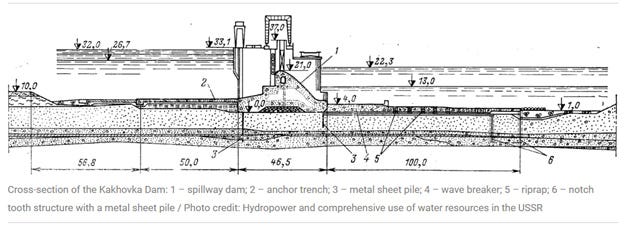
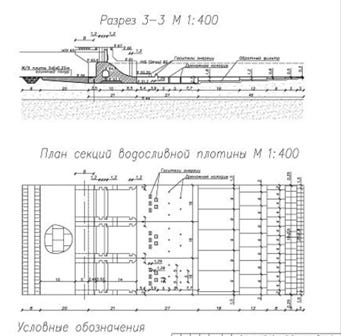

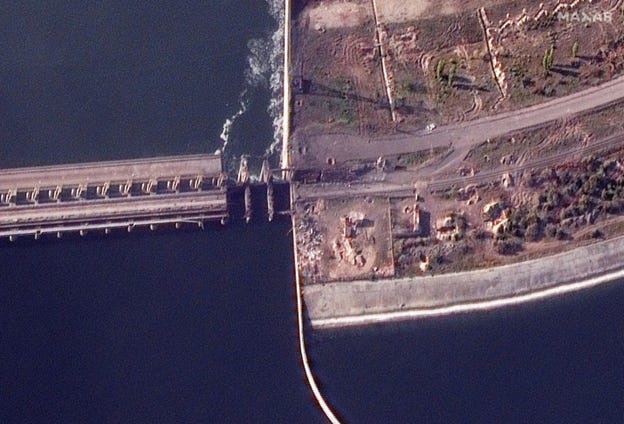
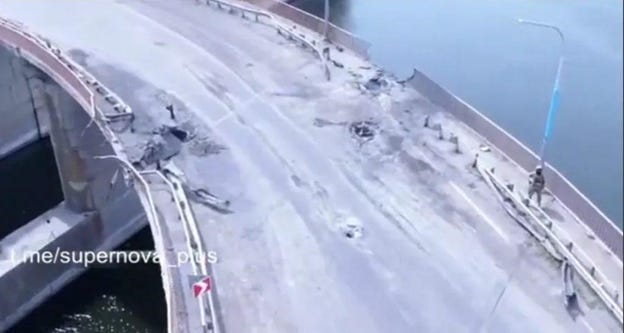
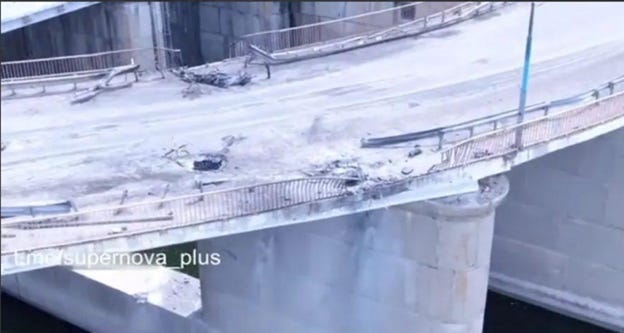
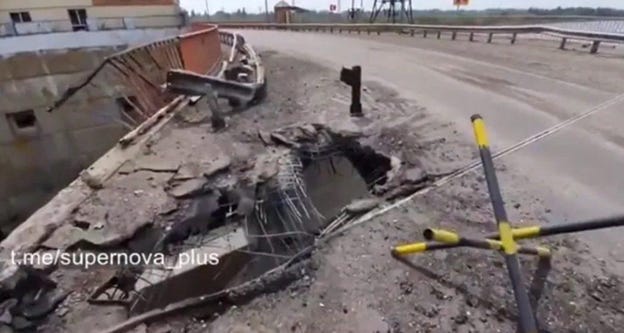
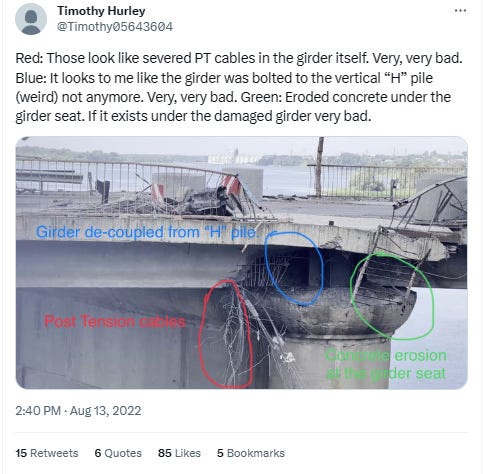
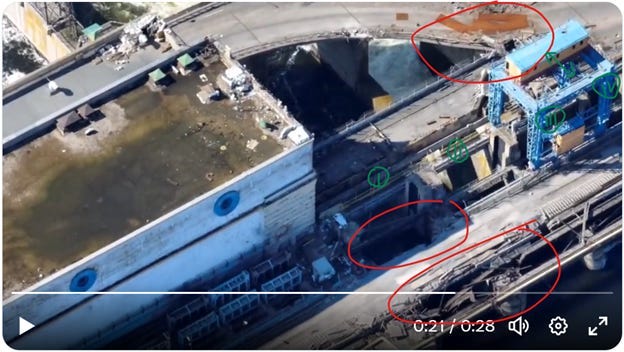




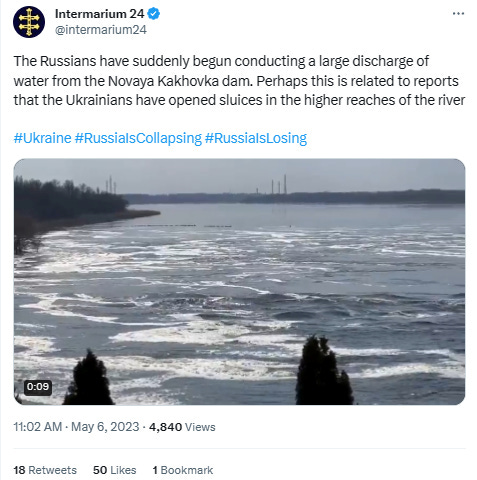
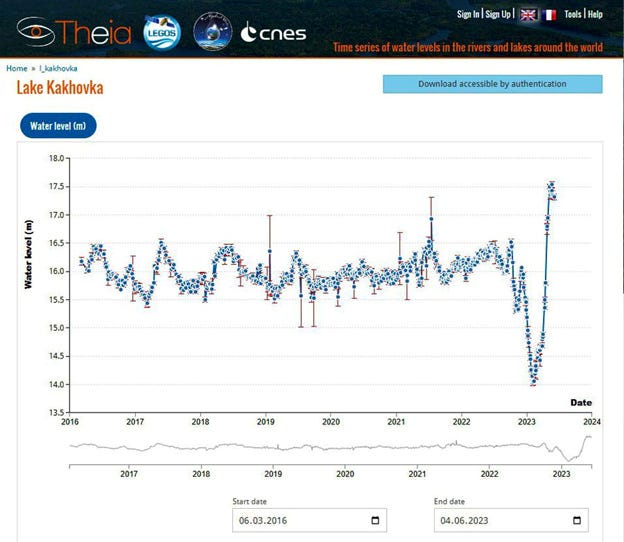
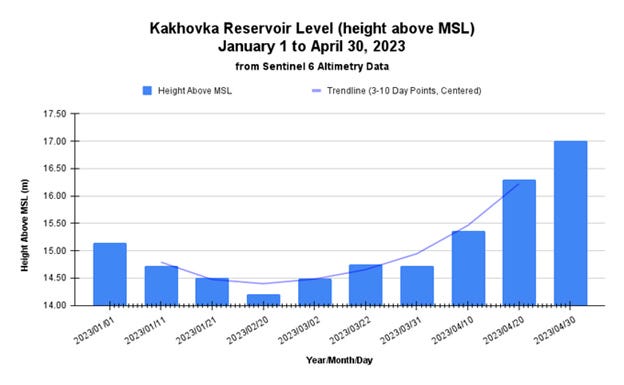
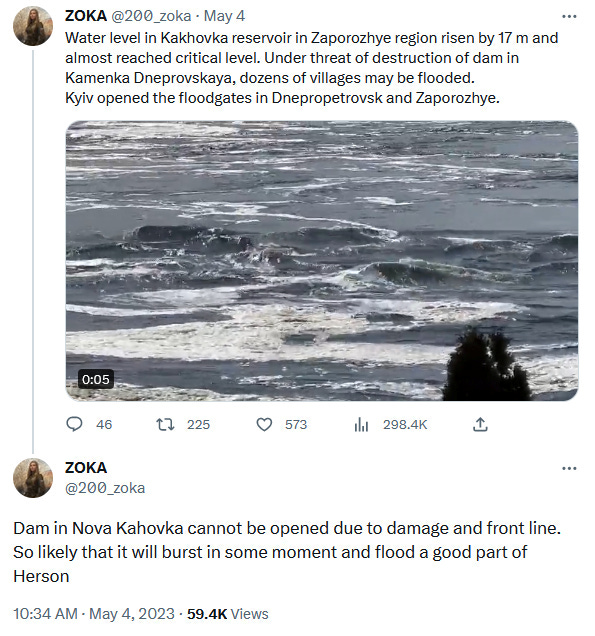




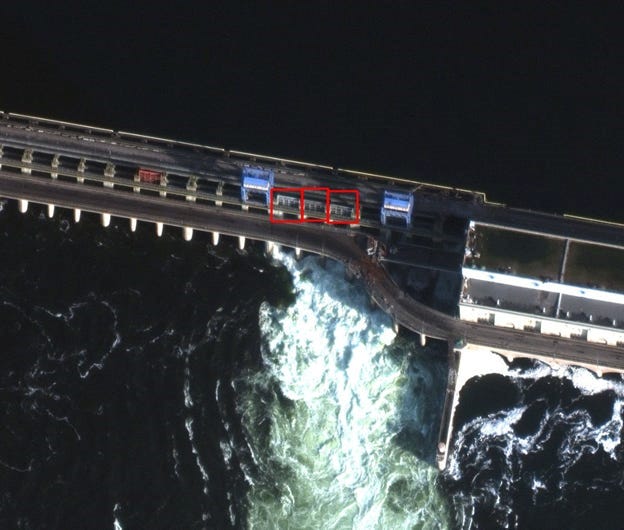
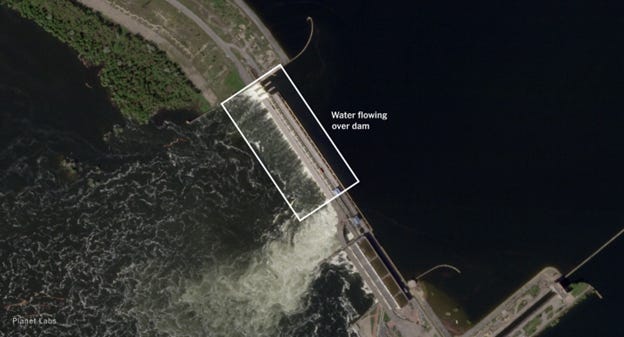
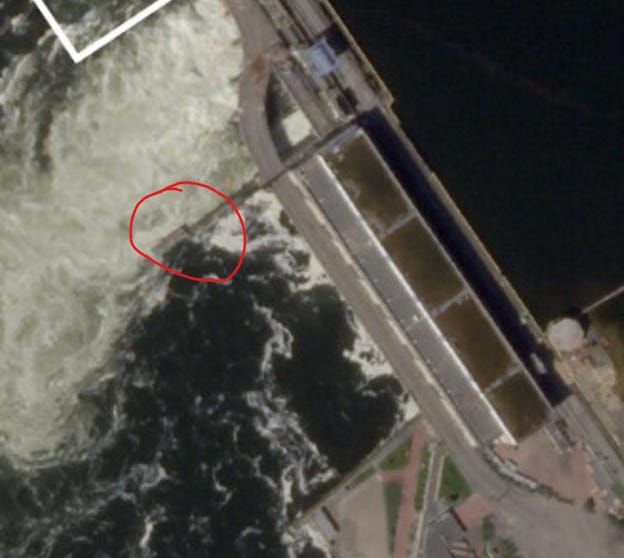

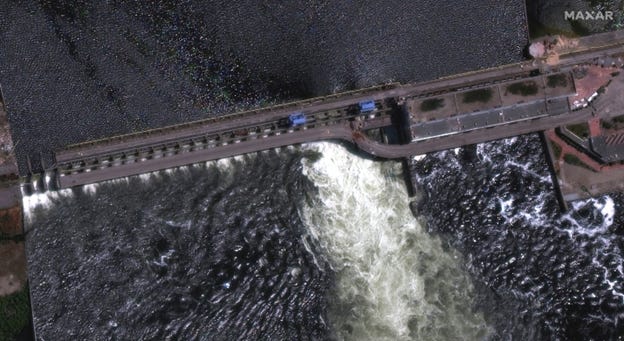
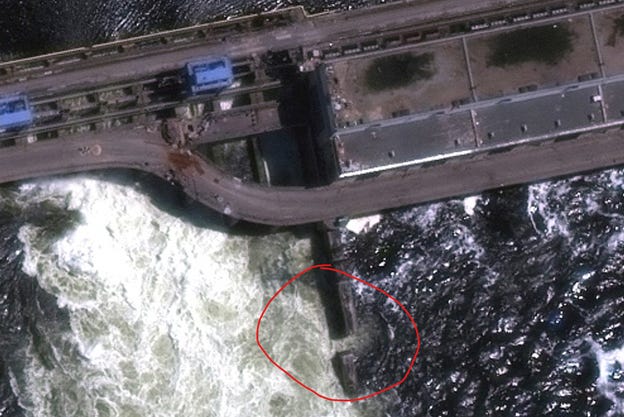
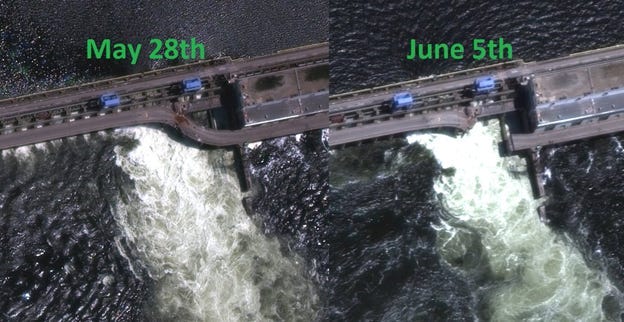

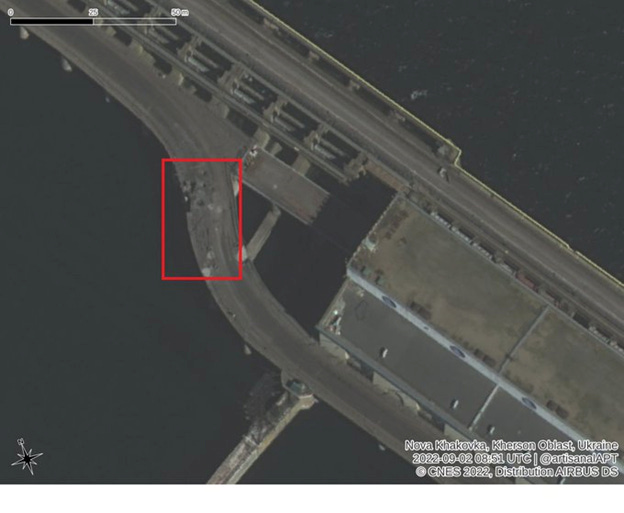


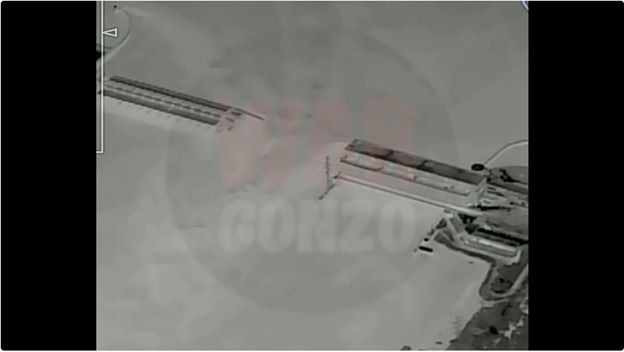



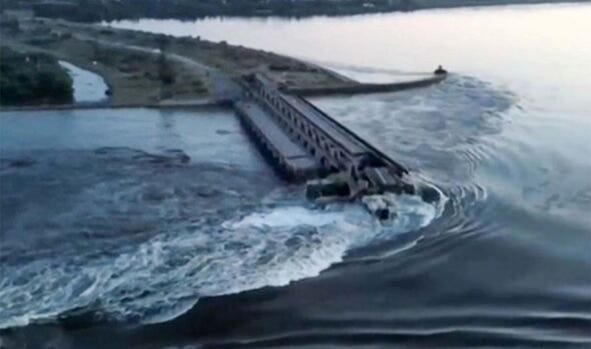
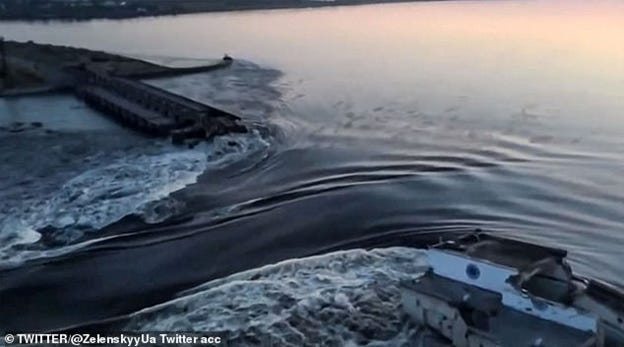
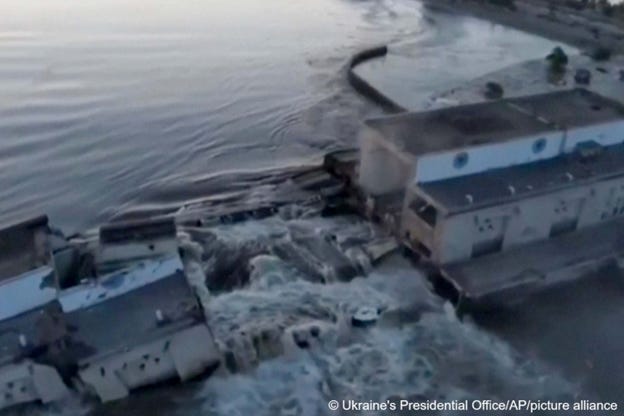
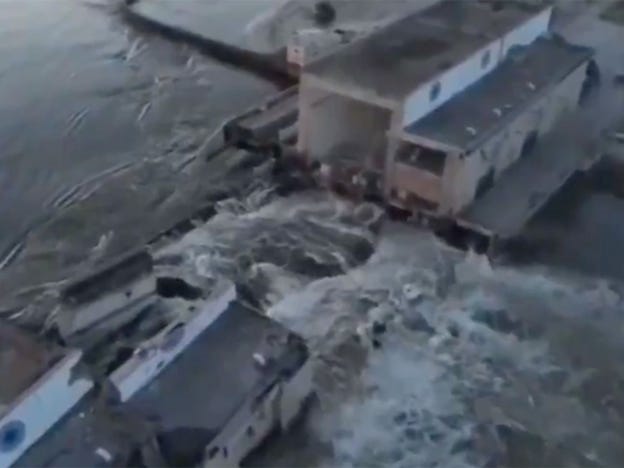
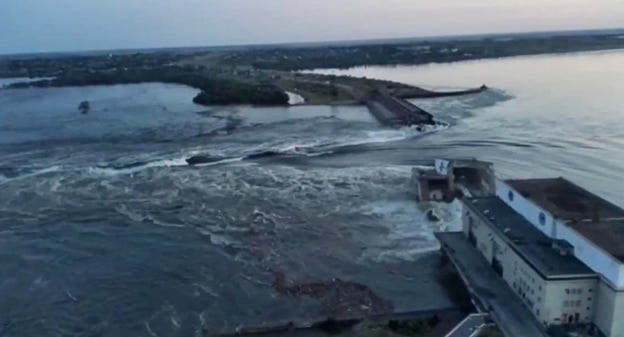


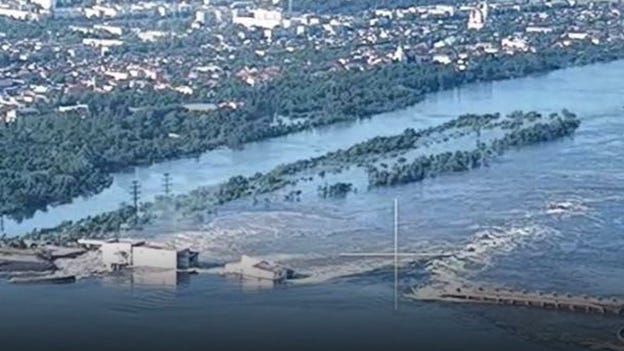

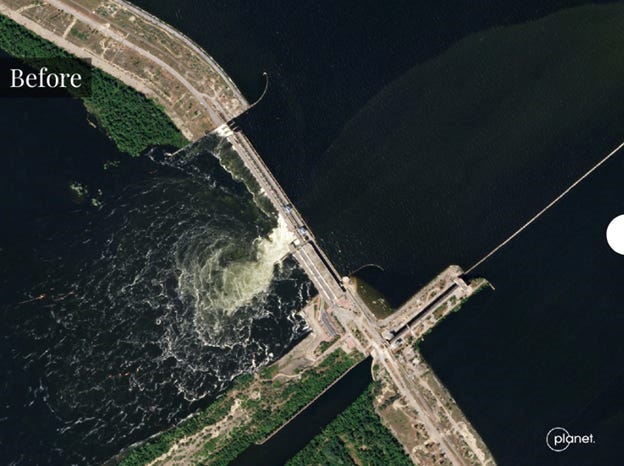
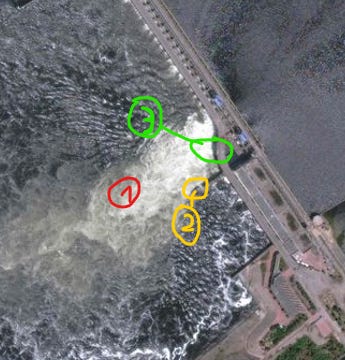
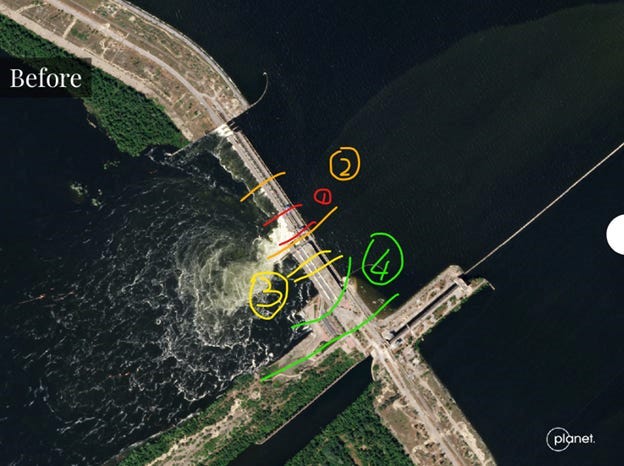
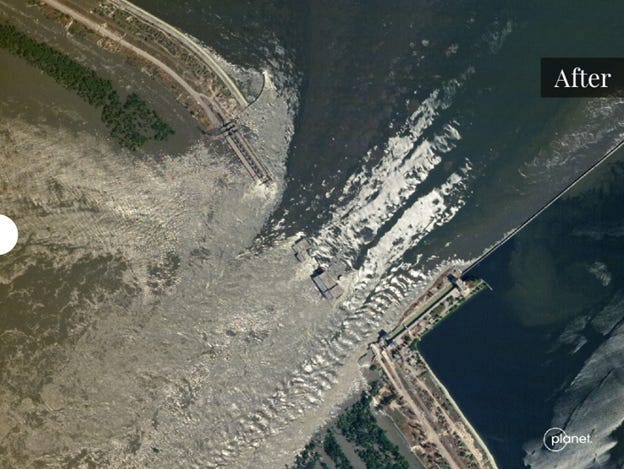

Your journalistic abilities put to shame the "journalists" at the mainstream outlets.